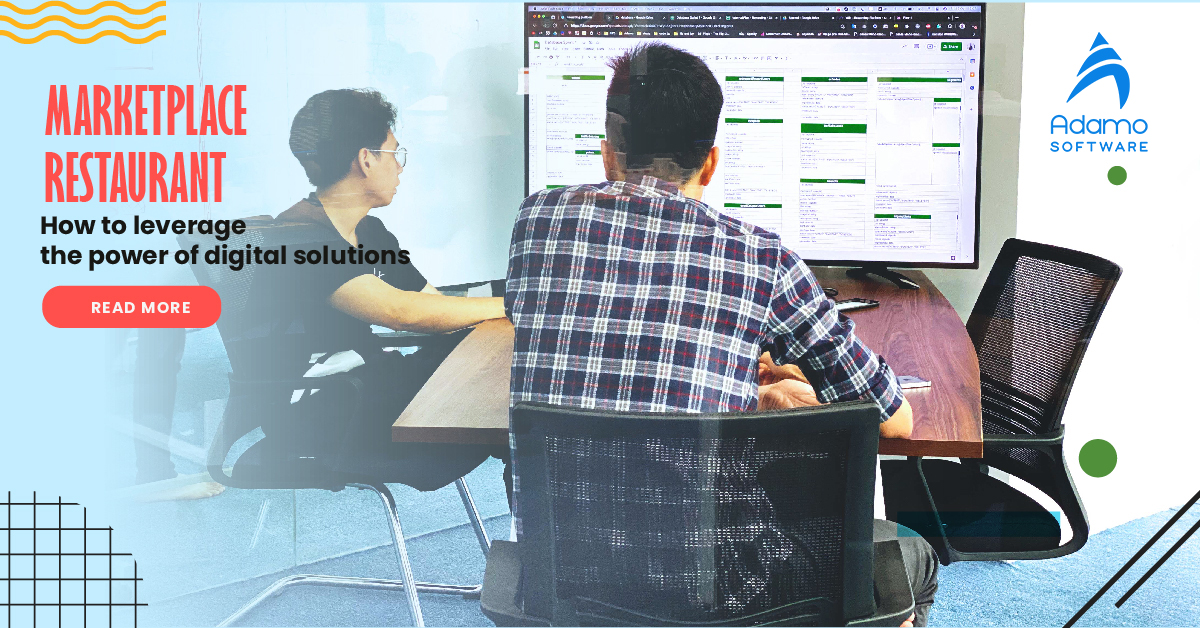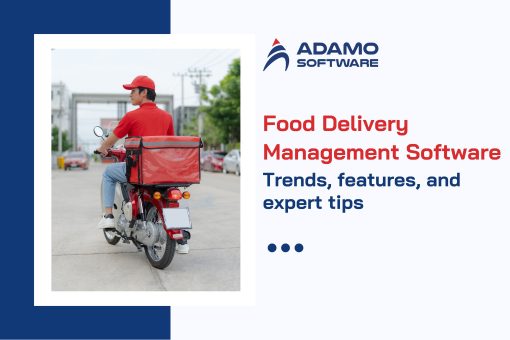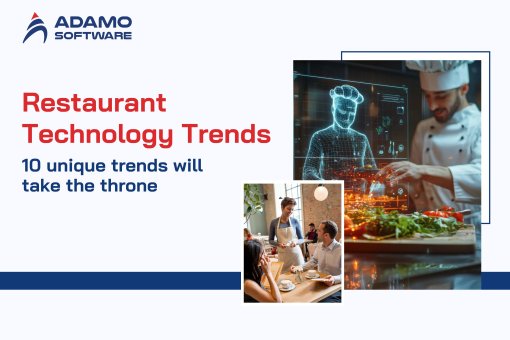Marketplace restaurant: How to leverage the power of digital solutions

The marketplace restaurant or restaurant marketplace has caught dramatic booming driven by the growth of online food delivery and shipping technology.
In fact, social distancing for a long time has been killing traditional restaurants. It forces them to change their business models to adapt to the demand of online food delivery among dinners these years. Working as a pure conventional restaurant without collaborating with third-party delivery or delivery platforms would be soonly diminished. Instead, cloud kitchen restaurants, virtual kitchens, or marketplace restaurants would form the new era in food and beverage industry services.
In this article, we tackled the concept of marketplace restaurant and its potential for booming in the future. For those who consider developing an online restaurant marketplace, we also show you some significant strategies to focus on.
The concept of Marketplace restaurant
The number of marketplace restaurant users has surged up to a new level. Statista reports showed that roundly 40% of American consumers used food delivery platforms as UberEATS, GrubHub, or Foodpanda at least once a month. Basically, those apps are not thorough examples of marketplace restaurants. So, what exactly marketplace restaurant?
Marketplace restaurant in the post-pandemic
The execution of marketplace restaurants offers an extreme advantage in the touch time of social distancing implementation.
A simple restaurant marketplace only offers a hub, a central platform, or a market space for virtual restaurants catching up with their potential dinners. Following the aggregator business model, most of the profits gained from the restaurant marketplace model tend to be from services fees and delivery charges.
In other words, the restaurant marketplace owners commonly hold technology. They adopt on-demand food delivery and restaurant ordering services in providing software infrastructures to both restaurants(providers) and users(customers). Accordingly, service charges here are not limited to delivery fees, but the cost that restaurants have to pay for listing in the marketplace.
Fully online execution is the driving force of the marketplace restaurant amidst the pandemic outbreak. The software logic is used commonly in many restaurant marketplace apps. It is divided into three separated log-in options.
_ Customer side: or user sign up to manage private orders, payments, and order tracking
_ Vendor side: restaurant build their own space for selling food, publish/ edit marketplace restaurant menus, manage orders, and track the revenue
_ Driver side: for shipper log in, provide tools for receiving, delivery booking track, and calculating wage as well.
| Customer side | Shipping side | Vendor side |
| Registration | Registration | Registration |
| Restaurant Searching | Order management | Order management |
| Ordering | Earning/ Revenue | Payment |
| Payment | Status | Menu |
| Position tracking | Promotion | |
| Review |
Solely in America, food delivery demand bombing gave significant rise in digital restaurant marketplace sales. The growth rate of sales in 2020 was seen a notable lift up by 124% over the report of 2019. That increase is predicted to continue to 2022 with a slower growth rate. The total market size of the digital restaurant marketplace in the US would be around US$ 64 billion, in which, DoorDash, Uber Eats, and Grunbhub takes the dominant market share.
International leaders of marketplace restaurants
Restaurant and hospitality refer to the location-based sector that internationalization the brand suffered several challenges. Accordingly, local restaurants take advantage of it by applying the successful business model of other similar restaurant marketplaces in the world.
The hidden driving force behind those successful restaurant marketplaces, such as Uber Eats and DoorDash capability and logistic background.
In the US, DoorDash was accounted for approximately 50% of the total online restaurant sale by 2020. Following this, Uber Eats refers to the rising star of offering over US$ 12.5 billion in sales last year. In which it enjoyed a 200% increase in sales annually. The business deal with Postmates would help Uber Eats marketplace hold 30% of total online restaurant marketplace sales at the end of 2021.
In the case of vaccination widely applied in many parts of the world, the growth rate of international marketplace restaurants would be expected to slow down to only 15% in 2022. However, it is not a bad deal. In the food and beverage industry, rooms for devoting to niche markets are still spacious.
Restaurant marketplace and Food marketplace strategies
Obviously, working with third parties (as a restaurant marketplace) has never been an easy plan due to collaboration challenges, especially in order management. Manual orders are obviously impossible that restaurant POS systems have to be installed for integrating with multi-restaurant marketplace brands.
Marketplace restaurant menu
If marketplace restaurants follow diversity strategies, they will not apply the same menu to all restaurant marketplace platforms. The custom promotion demand (especially for dishes) and even pricing strategy for each food marketplace force restaurants to execute menu psychology to maximined performance. Our suggestion is never to keep your marketplace menu in static form. Regular changing would add extreme benefits that you cannot imagine.
Three points you should keep in mind in creating menus for your marketplace performance:
_ Regularly analyze the performance of each item: As you might know, the behavior of users in food marketplaces is not the same. Accordingly, sometimes one particular item sells well in a restaurant marketplace generating bad performance in another. In this case, you should customize the menu based on past insight.
_ No one could understand your taste more than the staff: When having a list of dishes, you have to decide what items are featured in each restaurant marketplace. Your staff would have the answer for you since they hold the information of dinner’s behaviors.
_ Trust your historical research: The latest research on pricing would be recused in applying throughout the current campaign.
_ Do not forget SEO elements: To get more visibility in the restaurant marketplace, you should consider executing SEO strategies. Most Food marketplaces follow a search model. Accordingly, they provide search engine tools to users to find their target based on keywords. That’s why what words need to be added to your marketplace restaurant menu should be investigated. In other words, a nice name for dishes might not take effect in marketplaces.
Marketplace menu for online food shop
Depending on each nature of virtual marketplace restaurants, you need to decide the suitable pricing strategies for marketplace restaurant menu:
_ Promotion-based menu pricing strategies: Execute promotion campaigns based on selected dishes on menus and follow the general promotion periods of the restaurant marketplace. You might generate menus with specific features in a limited time only following each campaign.
_ Upscale menu pricing strategies: Allowing dinners to custom their meal by mixing items in minimalist menus.
_ Limited menu: for the seasonal item, you should apply a limited menu that the price would fit with the fresh menu item. This marketplace menu strategy is commonly suitable for farm-to-table restaurants.
_ Fixed price menu: Commonly used for specific events in a short period. You could launch a menu with a fixed price for meal kits.
_ Cuisine-based menu: This would be suitable for marketplace restaurants serving only some specific types of cuisine only.
You can explore about 10 Unique Restaurant Technology Trends will take the throne in 2026 here.
Must-have features in building a top restaurant marketplace
For businesses considering a new online marketplace restaurant, customizing a food and beverage software development application for a specific purpose takes time, obviously. One of the typical case studies to follow here is the uber eats marketplace, which has a clear set of features supporting the full customer journey.
1. Registration/ Log-in/ New account sign up
As mentioned above, an online restaurant marketplace needs three separate parts. Accordingly, the registration feature also consists of three different touchpoints.
_ Customer sign-up page should have a clear and transparent UI with minimum details. With the popularity of email and social media services, most restaurant marketplaces allow integrations to users signing in by accessing Facebook, Twitter, Google, or, other third-party accounts.
_ For shipping partners, the restaurant marketplace needs pages for shippers to log in with their custom profiles. Each shipper should create their own full identification for better management. Profile pages for shippers must be more creditable as the platforms take responsibility and control their behavior.
_ Restaurant registration and log-in similar to shipping partners with some additional information to display, including locations, menus, legal documents, and more.
2. Restaurant marketplace search engine
Customers or users are commonly using in searching for their target options. Regarding the restaurant marketplace search option, you might need navigation divided by categories, locations, cuisine, etc. The more specific search engine does, the higher satisfaction customers experience.
3. Ordering
One of the most essential features of marketplace restaurants is easy to order. Meal ordering takes an order period as the center that the ordering process has to be transparent and easy to process. The order Ui page should be clear for promotion code applied, meal reviews, number edit, notes, which are ready for payment processing. Additionally, a cart also helps customers manage their orders better. Any delay in ordering features would lead to customers switching to another marketplace.
4. Payment
the crucial thing in the payment feature is the capacity to intergrade with other e-wallet or payment gateways. The point is you have to provide multi-payment options to users, let them instant process the orders with a security guarantee.
For shipping and restaurant sites, the payment features have other meanings. It allows shippers and restaurants to withdraw their earning. By the way, it also needs integration with bank accounts, cards, or other money withdrawal methods.
5. Order tracking
Timing is the key in on-demand food delivery. That’s why order tracking will give customers more satisfaction. They will help the order status and especially the location of shippers. From the business context, it refers to an effective way to keep user retention in the restaurant marketplace. In practice, counters’ tracking commonly uses APIs from GPS providers.
6. Order management/ restaurant management
Restaurants need an order management feature to get the to-do list of dishes. It would let the restaurant kitchen know what dishes are on the line. On the other hand, restaurant management features would help restaurant menu management, details update, and more.
Restaurant management tools let restaurant owners stay ahead of their customers by issuing promotion codes, running advertising campaigns, and getting users to sharpen with your restaurant.
In conclusion, the custom restaurant marketplace or online food ordering platform tends to be a lucrative business even before and after COVID 19 outbreak. It reflects the change in dinners behaviors that take effect sustainably. For those who need a custom restaurant marketplace system, the above information would have you draw a clear picture for developing the custom software solution in the future.











